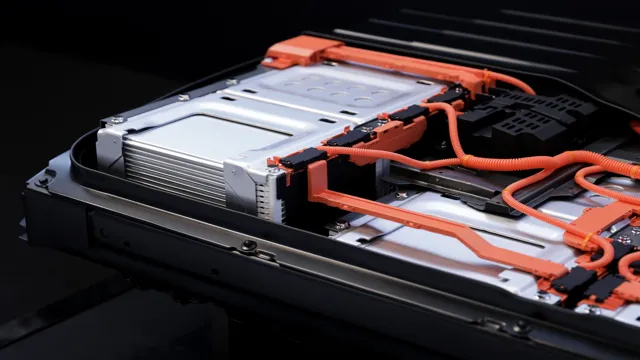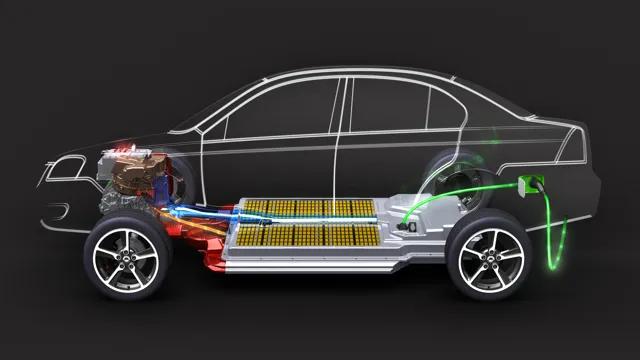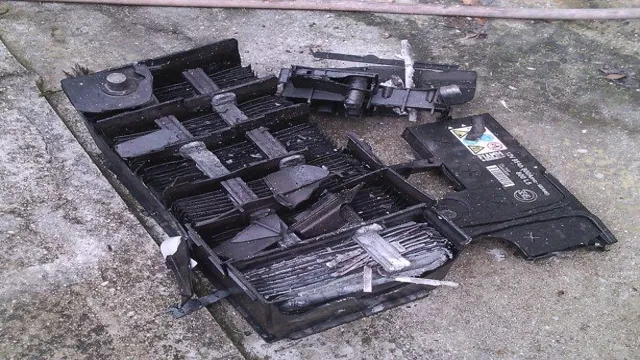Unleashing the Power within: A Comprehensive Guide on How Electric Car Batteries are Made!
Electric cars are quickly becoming the go-to choice for the environmentally-conscious, and for good reason: these cars produce no emissions, run quietly, require minimal maintenance, and feature advanced technology that improves performance. However, what really sets them apart from their gasoline-powered counterparts is their reliance on electric car batteries. These miraculous power sources are made up of a variety of materials, each of which plays a crucial role in powering your vehicle.
In this post, we’ll cover the materials used in electric car batteries and how they work together to keep you on the road. So buckle up and get ready to learn about the building blocks of modern electric vehicles!
Lithium-Ion Batteries
Electric car batteries are made of lithium-ion, a type of rechargeable battery commonly used in portable electronics. Lithium-ion batteries are composed of a positively charged cathode, a negatively charged anode, and an electrolyte that allows for the movement of ions between the two electrodes. The lithium-ion battery’s ability to hold more charge for longer periods of time makes it a popular choice for powering electric vehicles.
However, these batteries can be expensive and require frequent replacements, leading to concerns about their environmental impact. Despite this, continued research and development in the field aim to improve the efficiency and sustainability of lithium-ion batteries, making them an important component of the transition to a cleaner, more sustainable energy future.
Cathode materials
When it comes to the performance of Lithium-Ion batteries, one of the most critical components is the cathode material. Typically made up of lithium cobalt oxide, these cathodes are responsible for storing and releasing energy as the battery charges and discharges. However, research has found that other cathode materials such as lithium iron phosphate and lithium manganese oxide can offer improved performance in terms of safety, durability, and energy density.
These alternative materials are becoming more and more popular, particularly in electric vehicles, where their superior performance has advantages in terms of range and overall battery life. While there is still much to be learned about the behavior of these newer materials, their potential for improving battery performance is undeniable, and their continued development is an exciting direction for the future of Lithium-Ion batteries.

Anode materials
When it comes to lithium-ion batteries, anode materials play a critical role in the performance and longevity of the battery. The anode is the electrode through which the current flows into the battery during charging. Graphite has been the standard anode material for many years due to its high conductivity and stability, but as demand for higher energy density and faster charging rates increases, researchers are exploring other options.
One promising alternative is silicon, which can store up to ten times more lithium-ions than graphite. However, silicon is known to expand and contract during charging and discharging, which can lead to cracking and eventual failure of the battery. To tackle this issue, researchers have been working on developing silicon-based anodes with nanostructuring, coatings, and other modifications that can mitigate the expansion and prolong the life of the battery.
As lithium-ion batteries continue to power our daily lives, the search for better anode materials will undoubtedly continue.
Electrolyte materials
When it comes to Lithium-Ion batteries, the electrolyte materials play an essential role in their performance and safety. These materials serve as a medium for the flow of ions between the battery’s two electrodes, which are critical for the battery’s charging and discharging processes. An excellent electrolyte material should have a high conductivity of lithium ions and be stable at high voltages, temperatures, and currents.
The most commonly used electrolyte in Lithium-Ion batteries is lithium cobalt oxide, which is known for its high energy density and long cycle life. However, advancements in research have led to the development of other electrolyte materials, such as lithium iron phosphate, lithium titanate, and lithium manganese oxide, with similar or better performances. Innovations in electrolyte materials can significantly improve Lithium-Ion battery durability, allowing them to withstand charging and discharging at higher temperatures and rates.
These developments translate to longer battery life, higher energy densities, improved safety, and lower costs, thus enabling the widespread use of Lithium-Ion batteries in various applications such as electric vehicles and consumer electronics.
Nickel-Metal Hydride (NiMH) Batteries
When it comes to electric car batteries, they are typically made up of Nickel-Metal Hydride (NiMH) batteries. These batteries are known for having a high energy density, which means they can store a large amount of energy in a small space. They are also more environmentally friendly than other types of batteries, as they do not contain harmful chemicals like lead or cadmium.
NiMH batteries have been used in electric cars for many years, and while they do have some limitations (such as lower energy density compared to lithium-ion batteries), they are still a reliable and popular choice in the industry. So, the next time you see an electric car on the road, you can know that it’s most likely powered by NiMH batteries!
Cathode materials
When it comes to cathode materials in batteries, Nickel-Metal Hydride (NiMH) batteries have been around for a while now. They are a popular choice for hybrid and electric vehicles due to their high energy density. NiMH batteries consist of a cathode, an anode, and an electrolyte.
The cathode in NiMH batteries is typically made up of a mixture of nickel, cobalt, and manganese. These materials help to improve the stability and performance of the battery. One of the biggest benefits of using NiMH batteries is their ability to be charged and discharged repeatedly, making them a cost-effective option for many applications.
However, it’s important to note that the materials used in NiMH batteries can have environmental impacts if not recycled properly. Overall, NiMH batteries remain a reliable option for many applications, but newer and more advanced technologies are emerging as alternatives.
Anode materials
When it comes to anode materials, nickel-metal hydride (NiMH) batteries are a popular choice in the market. These batteries consist of a nickel oxyhydroxide cathode and a hydrogen-absorbing alloy anode. The NiMH batteries have a higher energy density and a longer lifespan than the nickel-cadmium (NiCd) batteries.
They are also more environmentally friendly, as NiMH batteries do not contain toxic materials like cadmium. However, the manufacturing process of NiMH batteries requires a lot of energy and resources, and the recycling process is often challenging. Nonetheless, NiMH batteries continue to be widely used in consumer electronics, hybrid vehicles, and other portable devices as a more affordable alternative to lithium-ion batteries.
With the demand for eco-friendly products on the rise, NiMH batteries remain a viable option as a sustainable and reliable energy source.
Electrolyte materials
Electrolyte materials Nickel-Metal Hydride (NiMH) batteries are a popular alternative to lithium-ion batteries due to their lower cost and greater energy density. The key to the success of NiMH batteries lies in their use of electrolyte materials, which are vital components of the electrochemical reaction that takes place within the battery. These materials enable the flow of ions between the electrodes, which is critical for the battery to function properly.
In the case of NiMH batteries, the electrolyte typically consists of a combination of potassium hydroxide and water, along with other additives to improve performance and increase lifespan. Choosing the right electrolyte material can greatly impact the efficiency, safety, and overall performance of a battery. As such, researchers are constantly exploring new electrolyte materials to improve on the existing technology and develop new batteries with even greater energy density, longer lifespan, and enhanced safety features.
Lead-Acid Batteries
Electric car batteries are made of several types of materials, but one of the most common is the lead-acid battery. This type of battery has been around for over a century and is still widely used today. Lead-acid batteries work by converting chemical energy into electrical energy through a process called electrochemical reaction.
This is done by immersing two lead plates in a solution of sulfuric acid, which creates a chemical reaction that generates electrons. The electrons flow from one plate to the other, creating a current that is then stored as potential energy. Despite their popularity, lead-acid batteries have some limitations, such as their weight and limited cycle life, which have made manufacturers seek alternatives such as lithium-ion batteries.
However, lead-acid batteries remain a reliable and economical option for many types of vehicles, including electric cars.
Lead electrodes and lead dioxide electrodes
Lead-acid batteries are one of the most commonly used batteries for various purposes like motor vehicles, uninterrupted power supply, and electrician’s backup power supply. These batteries are composed of two different types: lead electrodes and lead dioxide electrodes. The lead-acid battery generates electrical current through a chemical reaction between the lead and lead dioxide plates submerged in a dilute sulphuric acid solution.
The two electrodes charged up electrically through the application of a direct current. After charging, the lead dioxide electrode turns brown in color, indicating the fully charged status, while the lead electrode turns grey. In a lead-acid battery, the lead electrode serves as a negative terminal, while the lead dioxide electrode is the positive terminal.
The lead-acid battery has a longer life cycle than other types of rechargeable batteries, making it a useful and cost-effective option for a variety of applications.
Electrolyte solution of sulfuric acid
Lead-acid batteries are commonly used in applications that require high power outputs such as vehicles, uninterruptible power supplies (UPS), and backup generators. The electrolyte solution in these batteries is typically made up of sulfuric acid and water. The sulfuric acid is used to react with the lead plates in the battery and create an electrical charge.
It also acts as a catalyst for the reaction, speeding up the process of charging and discharging. The concentration of sulfuric acid in the electrolyte solution can vary depending on the battery’s design and intended use. In general, more acid will lead to higher performance but also more maintenance and potential for damage to the battery.
It is important to monitor the electrolyte levels and acidity regularly to ensure the battery is functioning properly. In summary, the sulfuric acid electrolyte solution is an essential component of lead-acid batteries and plays a crucial role in their performance and overall lifespan.
Conclusion
In conclusion, it’s electrifying to know that electric car batteries are made up of a complex combination of advanced materials such as lithium, cobalt, and nickel. Unlike the old-school lead-acid batteries, these modern powerhouses are more efficient, durable, and eco-friendly, making them the perfect choice for sustainable motoring. So, if you want to experience the future of transportation, hop on your electric car, rev up the battery, and let’s thunder down the road, leaving behind a trail of fossil-fuel exhaustion and embracing the renewable energy revolution!”
FAQs
What are the materials used to make electric car batteries?
Electric car batteries are typically made of lithium-ion cells, which consist of lithium cobalt oxide, lithium iron phosphate, or lithium manganese oxide.
How do electric car batteries differ from traditional car batteries?
Electric car batteries are different from traditional car batteries in terms of their composition, size, and capacity. Traditional car batteries are made of lead-acid chemistry and are much smaller than electric car batteries.
How long do electric car batteries last?
Electric car batteries can last from 8 to 10 years, depending on usage and maintenance. However, they typically have a warranty of 8 years or 100,000 miles, whichever comes first.
What is the process for recycling electric car batteries?
The process for recycling electric car batteries involves disassembling the battery pack, separating the components, and recovering valuable materials such as lithium, nickel, and cobalt. The recovered materials can then be used to make new batteries or other products.





